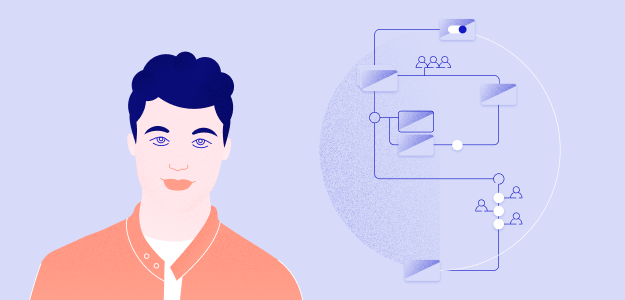Reducing energy consumption is a vital component of a business’s ESG goals. Sustainable software architecture is a new opportunity here that needs to be addressed.
It is a common misconception that software solutions are sustainable by default.
It is not so.
The ICT industry causes approximately 5-10% of the world’s energy consumption, and it is predicted to increase to 13% by 2030.
Non-sustainable software can easily consume 100 times more energy and create 1000 times more digital waste than sustainable software.
Helmes has unique ways of building sustainable software and criteria for delivering successful business solutions – plus, we have extensive experience in delivering projects.
How sustainable software can maximise business value?
Sustainable software engineering is better for the environment and can, at the same time, help a business to be more successful:
- An environmentally sustainable solution is well-engineered and well-optimised software that effectively solves a real business problem. This is what every business desires.
- Environmentally sustainable software does not generate additional costs and waste for ownership that could have been easily avoided, as it is energy-efficient and waste-minimising by design. It also translates into cost-efficiency for business.
At Helmes, we are proud to be an innovator in sustainable software development. Our unique method, the Helmes Way in building software development, produces efficient and sustainable software that benefits people, the business and, ultimately, the planet.
Helmes is building sustainable software for people, businesses, and the planet.
Reducing energy consumption is at the heart of building sustainable software architecture. Whilst this seems logical when considering sustainable software engineering, building sustainable software is much more than the carbon footprint. For example, at Helmes, building sustainable software covers a range of considerations outside of environmental sustainability and energy efficiency. Sustainable software, as we see it, is the best option for users, businesses and the planet.
Sustainable software solutions are designed in balance:
- To meet actual (business) needs;
- To make users´ life better;
- To minimise software architecture’s impact, chosen technologies, devices, and infrastructure have on the planet throughout their life cycle.
The main impact comes from service design, where business people, analysts, and service designers unite to build the right thing.
Designing useless software, however efficient, is always wasteful.
As business sustainability and the well-being of people are broad topics in themselves and have been addressed thoroughly before, we will focus on environmental sustainability in this article.
Environmentally sustainable software is definitely the best option for the planet. It is designed to minimise the impact that applications, software architecture, and the infrastructure that hosts them have on the planet.
Environmentally sustainable software, in a nutshell, is:
- Using less energy
- Using fewer resources
- Generating less digital and electronic waste
As an example, there are some approaches we use to ensure energy efficiency in software development from the purely technical aspect:
- Use energy-efficient infrastructure, tools, and algorithms for data processing
- Run energy-intensive processes during cheaper energy
- Minimise volume of unused data, its storage, and transportation
- Find smart reuse for leftover servers and devices
- Improve and optimise inefficient processes, algorithms and code
Environmentally sustainable software architecture ensures the software design is sleek, it is low-resource architecture, not under-engineered, not over-engineered, avoids using bloated third-party components where possible, removing unnecessary functionalities, integrations and stored data, all. Hence, the software is not ‘over-bloated’.
Our way at Helmes is to use agile and lean development methods that ensure the software is functional, not overengineered, environmentally sustainable and energy efficient.
What makes the Helmes Way so unique for environmentally sustainable software development?
If software development companies provide services, there are different service styles.
Team enhancement
Traditionally most businesses ask for ‘body leasing’ – where a client has asked for one, two or several software experts to match the criteria they need to complete tasks. This collaboration model does not guarantee that the software created is also environmentally sustainable.
Project-base
Another way of software development is project-based, where clients tell the software development partner, “this is the product I need; can you build me a solution?”
Whilst renting out individuals or working project-based does achieve positive outcomes, it needs to create teams to build sustainable, environmental and business-critical products on sustainable architecture. Ultimately the value added to a business is minimal.
As project-based collaboration is defined by the specifications that the customer creates, the environmental aspect depends on the requirements in the specifications.
Helmes Way: product team as a service
The Helmes way is more about building a sustainable, business-driving product. But instead of solely sending a few specialists to the client, we assemble a team who will take full responsibility for the digital and sustainable innovation and build the business technology. Every key role in our teams has a “check-list” to ensure sustainable choices.
How does Helmes’s product team build sustainable software?
As a business grows, its systems will consume more energy – from automated emails it sends to end users to every required report and system backup.
At this point, a business understands it needs to build more sustainable software. Still, it needs to know whether a new overhaul is required, how much it will cost, whether the architecture will be inefficient, or will support the continued growth goals of the organisation.
At this juncture, Helmes Way team has two responsibilities.
- To help our clients determine the software design and the components required (for testing and adoption).
- To test proof of concepts needed to be made and determine the project’s viability to understand the technology and energy costs involved.
With the above points, the software will be well-designed, and the project’s success rate will remain high.
For example, when considering building software, software engineers love to implement new technologies, test their viability and then hail the project a success.
At Helmes, we question what happens if a million users begin to use it. How will the software sustain this heavy load? Our engineers design the software and test proof of concept to ensure not if but when this occurs.
Most software developers would advise clients to buy more servers to handle this increased user base. However, for us, this represents two critical flaws.
- Firstly, new servers mean more energy consumption, increasing a business’s environmental footprint.
- Secondly, if this is not viable, new software must be built on top of the existing architecture, making the entire system over-bloated. Quite often, the upkeep does not end with ‘just throw in some more servers’ but also with extra people for maintenance.
Thus, our teams are adept at ensuring this never happens.
Helmes Way teams have defined ssential roles in delivering high-quality results, considering all three aspects: people, the business and the planet. For over 15 years, we have fine-tuned their work methods so that all the team members play together as a professional orchestra. These key roles also have specific task lists on how their role can contribute to creating environmentally sustainable software.
Why is this important: business representatives, analysts and architects often decide on real environmental sustainability. Developers can only do so much when all other important decisions are already made.

Business analysts
A Helmes business software analyst is responsible for analysing an organisation’s software needs and recommending solutions to improve business processes and operations.
Our analysts will educate the business stakeholders on the principles of sustainable software to identify opportunities for software improvement and develop plans to implement and maintain software systems.
Some of the critical responsibilities of a business software analyst include the following:
- Analysing the business, the processes, needs and requirements, identifying and evaluating problems and opportunities for feasible digital solutions.
- Providing alternatives and recommendations on possible digital solutions that solve the business problems, help to achieve the business objectives, and provide the best return on investment.
- Developing development roadmaps and project plans together with the business and development teams, outlining timelines, budgets, and resources needed to implement software solutions.
- Collaborating with software development teams and different partners to ensure the software solutions meet business requirements and are delivered on time and within budget.
- Reviewing, testing and evaluating software solutions to ensure they meet quality standards and are user-friendly.
- Training and supporting users to ensure they are comfortable and proficient with new software systems, and addressing new issues that come from using the software.
Helmes software analysts are crucial in helping organisations leverage technology to improve their operations, increase efficiency, and achieve their business objectives. Let me share a sneak peek into the key roles in building sustainable software.

Software Architects
Engineers build the solution. Software architects design it. Our architects make high-level design, define standards, and decide which technologies, platforms, and tools are optimal to solve the business problems.
Ultimately they will question the following:
- How much computation power does it need to match the business needs?
- What is the optimal infrastructure and technology on top of which the solution is running?
- Will the architecture be scalable where needed and energy efficient?
- Can this remain sustainable with new future growth?
The software architect thinks about all of the above.

Lead Developer – Technical Lead
Our technical leads are responsible for leading the software development teams. The lead developer is crucial in aligning the technical work with the business objectives.
Lead developers are considered the bridge between the development team and the business. They are equipped with programming expertise and experience, which allows them to communicate effectively with developers with different technology skill sets. On top of that, they also assist the development team in resolving technical issues.
At Helmes, our Technical Leads ensure that the architect’s vision and design are implemented in a way that works and is followed correctly – that software developers do not build software architecture in an unsustainable way but in the way, the software architect intended.
In some cases, the Technical Lead will even give feedback to the Software Architect that although the architecture is designed well, there could be a disconnect in actually building the software – acting like a feasibility check and balance between the architect and development team.

Software Engineers who reimagine how development is done
Developers will sometimes carry out development tasks how they were taught or the last time they were asked to develop software. Most of their mindsets are “it seems to work good enough, and I built it fast; job done.”
However, our mindset at Helmes is vastly different.
When we hire talent, we encourage them (and lead them through our Technical Leads) to think, “this is not optimal or good enough for this project, as each client, business, and project is different.”
For instance, developers are taught from an early stage in university to mostly think of when software has only few users. However, when it has 100,000 users, there’s a 10-times; when it comes to 1,000,000 users, there’s may be 100-times or more difference in power consumption.
So rather than taking about one user algorithm at a time, our developers need to consider algorithms at scale.
If they need help understanding the complexities, this is where our Software Architect and Lead Developer step in and ensure that everyone understands.
And, yes, efficiency is also one of our core values. It is marketing buzzword only as long as it is not fully implemented into the actual work culture.
Audit of the business process and its digital solution sustainability
The audit business process for sustainable software, including digital waste, typically involves thoroughly examining an organisation’s data lifecycle and digital waste management practices to identify areas where waste reduction and sustainability can be improved. They will collaborate with the software architect and infrastructure architect to cover both sides of the digital solution.
Within the audit, they will:
- Map the business process end-to-end (including extending outside of the product to other partners)
- Specify current business operations volume, users activity, and predicted future growth
- Identify and measure energy inefficiency and digital waste in the resources and activities of the business process (current situation vs expected future growth)
- Provide sustainable alternatives (consider optimising business process, software, and infrastructure)
- Calculate the impact (cost-saving or environmental) over the product lifetime considering the expected growth in business operations and users activity. These calculations help the business to make smart choices.
Involving in-house teams and other partners
Our teams may be building one component of the software. Still, it is usual that another part comes from another company or the client’s in-house team and needs to be integrated into the overall software architecture.
All these systems work together, interconnected, and each of these integrations brings new challenges in ensuring software is not over-engineered. Otherwise, if these are not adopted, more digital waste is created, and more energy consumption is generated.
Our engineers take the lead in ensuring that all integrations with internal and external partners are minimised to reduce energy consumption.
Not many, even the clients themselves, consider this. However, we do.
Get in touch




